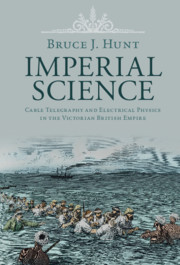Book contents
- Imperial Science
- Science in History
- Imperial Science
- Copyright page
- Contents
- Figures
- Acknowledgments
- Abbreviations
- Prologue: “An Imperial Science”
- 1 “An Ill-Understood Effect of Induction”
- 2 Wildman Whitehouse, William Thomson, and the First Atlantic Cable
- 3 Redeeming Failure
- 4 Units and Standards
- 5 The Ohm, the Speed of Light, and Maxwell’s Theory of the Electromagnetic Field
- 6 To Rule the Waves
- Epilogue Full Circle
- Bibliography
- Index
- References
Bibliography
Published online by Cambridge University Press: 11 December 2020
- Imperial Science
- Science in History
- Imperial Science
- Copyright page
- Contents
- Figures
- Acknowledgments
- Abbreviations
- Prologue: “An Imperial Science”
- 1 “An Ill-Understood Effect of Induction”
- 2 Wildman Whitehouse, William Thomson, and the First Atlantic Cable
- 3 Redeeming Failure
- 4 Units and Standards
- 5 The Ohm, the Speed of Light, and Maxwell’s Theory of the Electromagnetic Field
- 6 To Rule the Waves
- Epilogue Full Circle
- Bibliography
- Index
- References
Summary

- Type
- Chapter
- Information
- Imperial ScienceCable Telegraphy and Electrical Physics in the Victorian British Empire, pp. 276 - 298Publisher: Cambridge University PressPrint publication year: 2021

